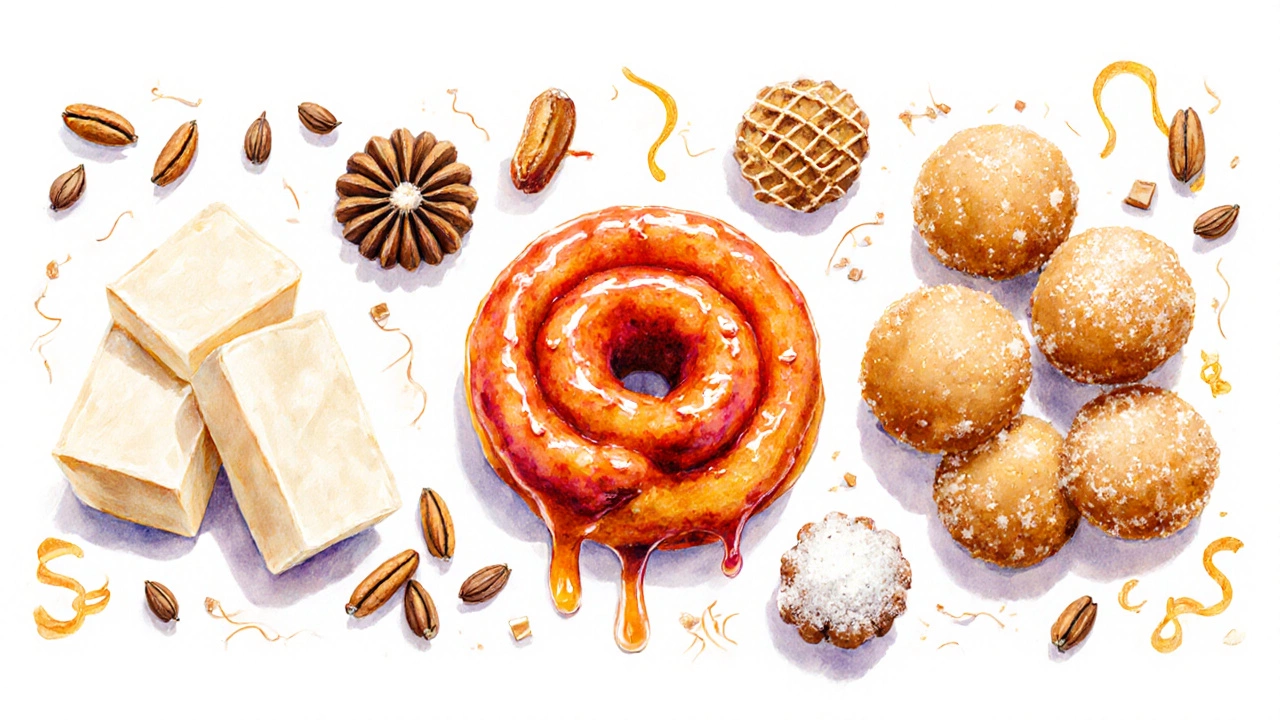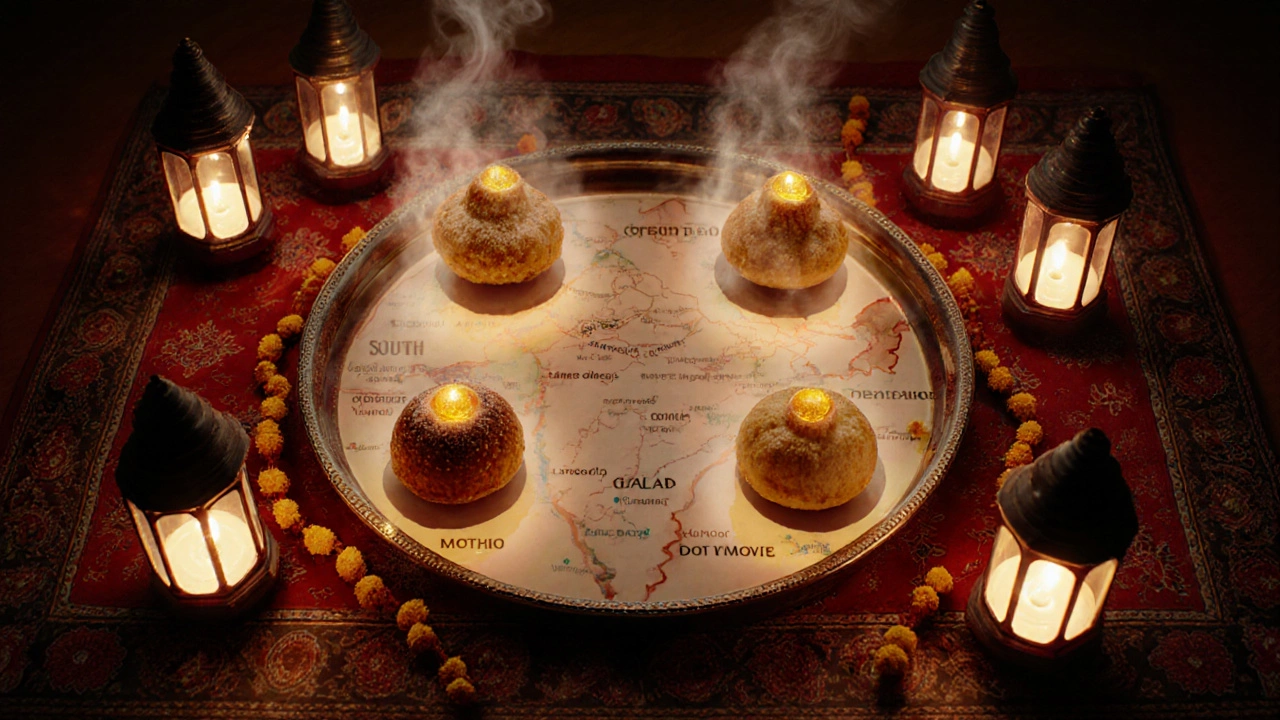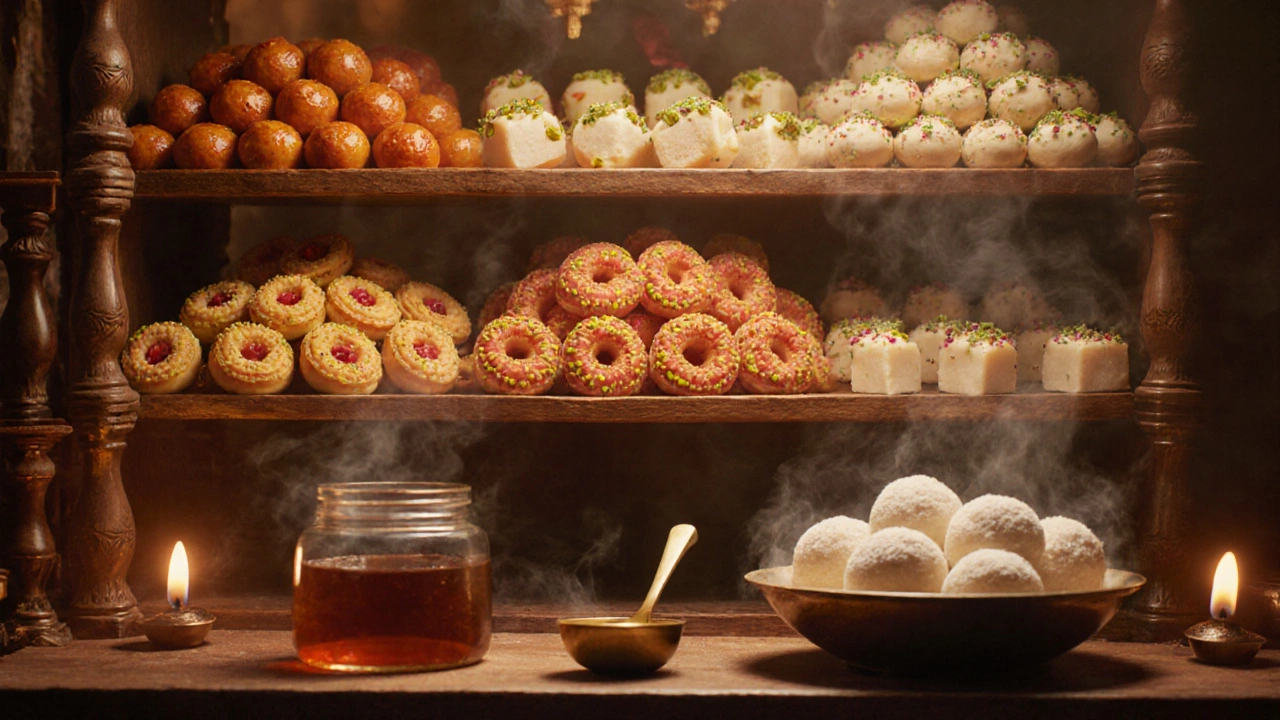Indian Sweet Name Explorer
Discover the world of Indian sweets! Explore by category, region, or ingredient to learn about popular mithai and their unique characteristics.
About Indian Sweets (Mithai)
Indian sweets, known as Mithai, are a diverse collection of desserts made from sugar, milk, nuts, and aromatic spices. Each region has its own specialties based on local ingredients and traditions.
Popular examples include Barfi (milk-based), Gulab Jamun (milk-based), Jalebi (flour-based), Ladoo (sugar-based), and Rasgulla (cheese-based).
Ever walked into an Indian bakery and wondered what all those colorful treats are called? You’re not alone. In India, the word for “sweet” isn’t a single name but a whole family of names that vary by region, ingredient, and occasion. Below you’ll find a clear guide that breaks down the most common terms, the flavors behind them, and when you’ll actually see them on the table.
What "Mithai" Means
Mithai is a collective term for Indian sweets, typically made from sugar, milk, nuts, and flavored with cardamom or saffron. Think of mithai as the umbrella that covers everything from soft, syrup‑soaked balls to crunchy, fried ribbons. The word comes from the Hindi verb “mithā” meaning “sweet”. When someone asks you for “mithai”, they’re really asking for the full sweet spread that families serve during festivals, weddings, or even as a daily treat.
Major Types of Indian Sweets
Indian sweets can be grouped by the base ingredient that defines their texture and taste. Below are the most common categories and a few classic examples you’ll meet at any Indian sweet shop.
- Milk‑based sweets - These rely on condensed milk, khoya (reduced milk solids), or paneer. Famous names include Barfi, a fudge‑like square flavored with pistachios or rose water, and Gulab Jamun, deep‑fried milk dough balls soaked in sugar syrup.
- Flour‑based sweets - Made from wheat or gram flour, these are often fried before being drenched in syrup. Jalebi is the most iconic: a crunchy spiral that glistens with orange‑red syrup.
- Sugar‑based sweets - Simple but addictive, they use sugar as the main body. Ladoo fits here, as tiny round balls rolled from roasted flour, sugar, and ghee.
- Nut‑rich sweets - Packed with almonds, cashews, or pistachios, these add texture and richness. Soan Papdi is a flaky, honey‑comb‑like treat that melts in the mouth.
- Rice‑based sweets - Using rice flour or rice grains, they’re often light and milky. Rasgulla (soft spongy balls) and Kheer (rice pudding) belong to this family.

Regional Favorites
India’s culinary map is huge, and each state has its signature mithai. Below is a quick look at what you’ll typically find in the north, south, east, and west.
| Region | Signature Sweet | Main Ingredient |
|---|---|---|
| North India | Gulab Jamun | Khoya (milk solids) |
| South India | Jalebi | All‑purpose flour (maida) |
| East India | Rasgulla | Chhena (fresh cheese) |
| West India | Shree Modak | Rice flour and coconut |
| Central India | Barfi | Condensed milk |
Notice how the base ingredient changes with geography. In the north, dairy dominates; the south leans on flour and syrup; the east favors fresh cheese; the west embraces rice and coconut. Knowing this helps you guess the sweet you’ll encounter even before you see it on the menu.
How They're Made - Common Ingredients
Even though each sweet has its own story, they all share a handful of pantry staples. Understanding these basics can demystify the process and help you recreate a few at home.
- Milk and its derivatives - Fresh milk, condensed milk, khoya, or paneer provide the creamy base for most mithai.
- Sugar - Used as syrup, powdered sugar, or jaggery (unrefined cane sugar) to add sweetness and preserve the treat.
- Ghee (clarified butter) - Gives a glossy finish and rich flavor. It’s also the frying medium for many fried sweets.
- Nuts and seeds - Almonds, pistachios, cashews, and poppy seeds add crunch and visual appeal.
- Spices and aromatics - Cardamom, saffron, rose water, and kewra (screwpine) turn plain sugar into a fragrant confection.
When you hear a sweet described as “khoya‑based” or “saffron‑infused”, those are the clues that tell you which of the ingredients above is at play.
When to Enjoy Indian Sweets
In India, sweets are not just desserts - they’re part of rituals. Here’s a quick guide on when you’ll most likely see them appear.
- Festivals - Diwali, Raksha Bandhan, and Holi tables are piled with assorted mithai.
- Weddings - A “lagan” (wedding feast) often includes a sweet platter called “mithai thali”.
- Everyday treats - Many families keep a small jar of Ladoo or Barfi for guests.
- Religious offerings - Temples receive sweets like Peda as “prasadam”.
So whether you’re attending a grand celebration or just stopping by a local sweet shop, there’s always a cultural moment attached to the treat.

Tips for Buying Authentic Mithai
Not all mithai are created equal. Here’s how to spot the good stuff.
- Freshness - Look for a bright sheen on syrup‑soaked sweets. Stale treats will appear dull.
- Ingredient list - Authentic sweets list ghee, real milk, and real nuts. Avoid products that rely heavily on artificial flavors or palm oil.
- Texture - A perfect Jalebi should be crunchy on the outside yet juicy inside. If it’s soggy, it’s likely reheated.
- Origin - Some cities are famous for specific sweets (e.g., “Mysore Pak” from Mysore). Buying from a reputable shop in that city guarantees authenticity.
Key Takeaways
- The umbrella term for Indian sweets is Mithai, covering everything from milk‑based bars to flour‑based spirals.
- Common types include Barfi, Gulab Jamun, Ladoo, Jalebi, Rasgulla, Soan Papdi and Kheer.
- Regional variations are driven by local ingredients: dairy in the north, flour in the south, cheese in the east, and rice in the west.
- Key ingredients - milk, sugar, ghee, nuts, and aromatic spices - appear in almost every mithai recipe.
- Look for freshness, real‑ingredient labels, proper texture, and reputable origins when buying sweets.
Frequently Asked Questions
What does the word "Mithai" literally mean?
"Mithai" comes from the Hindi word “mithā”, which means “sweet”. It is used across India to refer to any confectionary dessert.
Are all Indian sweets made with dairy?
Most traditional mithai use milk or its derivatives, but there are notable exceptions like Jalebi (flour‑based) and Rasgulla (cheese‑based).
Which Indian sweet is best for people with nut allergies?
Simple sugar‑based sweets like Ladoo made with toasted gram flour (instead of nuts) are safe choices.
Can I store Indian sweets for a long time?
Dry sweets like Barfi or Soan Papdi keep well for a few weeks in an airtight container, while syrup‑soaked sweets like Gulab Jamun should be refrigerated and eaten within a few days.
Where can I buy authentic Indian sweets outside of India?
Look for Indian grocery stores that import mithai from well‑known manufacturers, or shop online from certified Indian sweet brands that ship internationally.
Next time you see a tray of bright, syrupy delights, you’ll know exactly what they’re called and why they taste the way they do. And if you ever want to try making one at home, you now have the ingredient checklist to get started.
Indian sweets are more than just desserts - they’re a cultural language spoken across the subcontinent. Understanding the names, the regions, and the ingredients lets you taste the story behind every bite.
